From the first hours of the Normandy landings, Caen was a strategically important point on the way to the liberation of France. Unfortunately for the Allies, the commander of the 21st Army Group, General Bernard Law Montgomery, led the attack on the city. Proud, always right and ... hopelessly inept.
According to Monty's assurances, Caen was to be conquered on the first day of the invasion of Fort Europa, on June 6, 1944. The British 3rd Infantry Division was assigned to this task (Poles also fought in its ranks), which at 7:30 am landed on the beach marked with the code name Sword.
Therefore, on the night of June 5-6, the city was bombed by the RAF as part of the strategy to slow down German reinforcements. Around 2,500 tons of bombs fell on Caen, killing over 800 people and turning the city into a sea of rubble.

Caen was almost razed to the ground as a result of a carpet raid on the night of June 5-6. The scale of the damage is perfectly shown by this photo, taken after the allied forces entered the city.
Good, bad beginnings
It was an astonishing tactical move by the Bomber Command, made at the request of General Montgomery himself, who wanted Caen to be seized by the next evening at the latest. The ruins left over from the raid only made it difficult to take the city out of the way. The Allies should have been aware of this - knew, for example, the history of the Stalingrad battle. Well, Monty knew better.
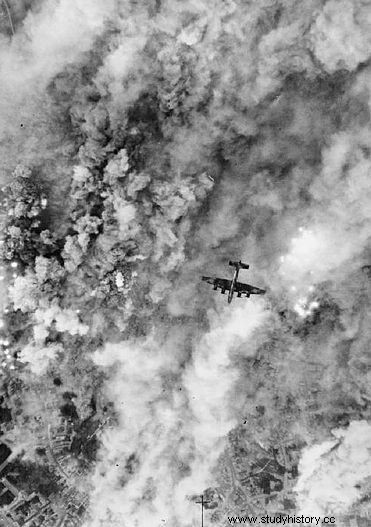
British Halifax bomber during one of the numerous air raids on Caen. July 1944.
Things went well at first, and the 3rd Division took its beach the fastest of all Allied tactical units involved in the landing. These were, however, good bad beginnings. British soldiers were unable to cope with the German coastal fortifications.
The most problematic were the reinforced concrete bunkers with 105 mm guns bearing the names Hillman and Morris, located on the Periers hill near the landing site. The problems resulted mainly from the decisions of Monty and General Miles Dempsey, commander of the 2nd Army.
They did not take into account such a scenario in their plans and did not equip the sub-units of the 3rd Division with Churchill AVRE tanks (intended for this type of task). The attack was therefore significantly slowed down, and after the 12th SS Panzer Division "Hitlerjugend" and other armored divisions of the Waffen-SS entered combat, it completely stopped in place.
Monty and his new, even better plan
After a few days it was already known that the leading attack on Caen had not brought any results. Therefore, in order not to lose face in the High Command of the Allied Expeditionary Forces, General Montgomery had to revise his attack concept.
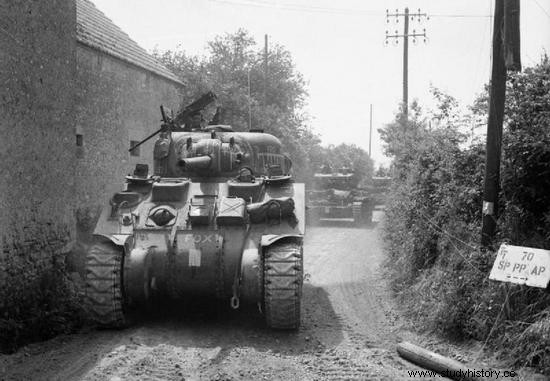
Sherman and Cromwell tanks on their way to Tilly-sur-Seulles. June 13, 1944
He presented it on June 10, near the town of Port-en-Bessin, to the commander of the American 1st Army, General Omar Bradley. This time, a frontal attack on the city was replaced by a daring circling maneuver.
The double encirclement was to be led by two divisions favored by Churchill's favorite, namely the 7th Panzer Division (the famous Desert Rats) and the 51st Infantry Division (Highland). Both formations were part of the British 8th Army, which under Monty's command followed the combat route from the Battle of El-Alamein, through Sicily, to the Apennine Peninsula.
The plan assumed that the 51st Division, additionally strengthened by the forces of the 4th Armored Brigade, would be the left arm of the encirclement, with the task of capturing Cagna. In turn, attacking from the right flank, the 7th Division will strike from the area of Tilly-Sur-Seulles and move through Caumont towards the village of Evrecy.
The most surprising element of the entire operation was to be a landing by the British 1st Airborne Division - the absolute reserve of the British army - in the deep rear of the Germans near Evreca. The discharge south of Caen was planned to be carried out in broad daylight, which was a precedent.
This article has more than one page. Please select another one below to continue reading.Attention! You are not on the first page of the article. If you want to read from the beginning click here.
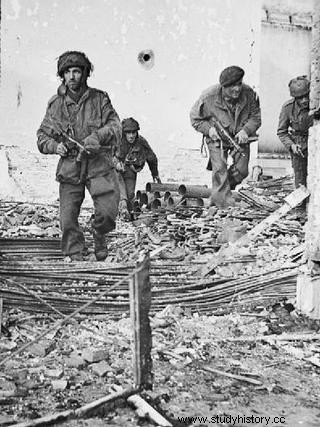
It was close to turning the soldiers of the British 1st Airborne Division into cannon fodder in Gen. Montgomery's brilliant plan.
Most of this type of action took place after dark, for fear of German anti-aircraft fire. The task of the rest of the Allied forces was to reach the paratroopers who were deprived of heavy anti-tank weapons and surrounded by enemy territory as quickly as possible.
The controversial plan met with opposition from many Allied commanders, including Sir Trafford Leigh Mallory, then in command of the Allied Expeditionary Forces air force.
He argued that during the day his transport planes carrying paratroopers would be massacred by the strong German anti-aircraft artillery in the vicinity of Caen and Evrecy. It also ruled out an operation at night, as the transports would have had to pass over the invasion fleet, which refused to cease fire completely due to nighttime Luftwaffe raids.
After all, due to objections from "the cowardly jerk" (a nickname Monty uses for Leigh-Mallory), Dwight Eisenhower canceled the paratroopers' landing. As the development of events showed, it was a very good decision.
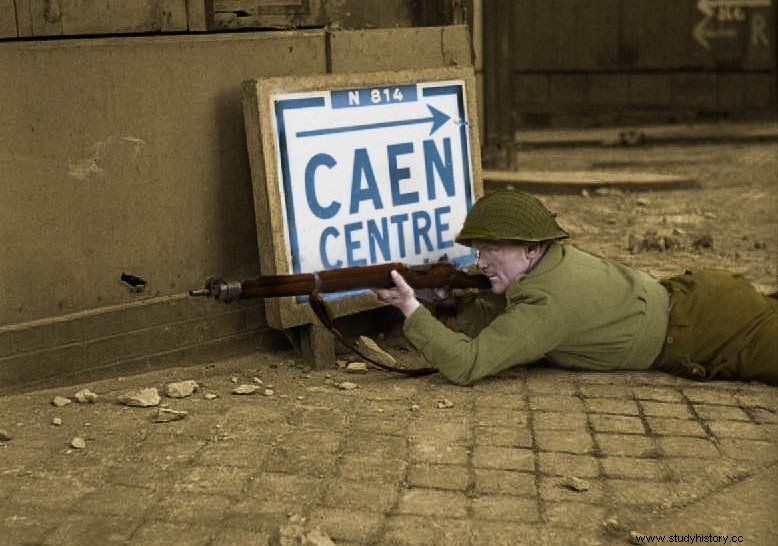
A Canadian soldier looks for German snipers during the fights for Caen. Photo from July 1944.
Broken key to Cherbourg
The outline of the plan - even after the withdrawal of the 1st Airborne Division - looked very good on the staff maps. The reality, however, was quite different. From the very beginning, on June 11, the operation started to limp.
Accustomed to fighting in the open spaces of North Africa, the 51st Division could not cope at all in Normandy. The daily fights there consisted of short and very violent clashes combined with sudden artillery and mortar fire. The Black Guard soldiers were so stunned that they hardly moved.
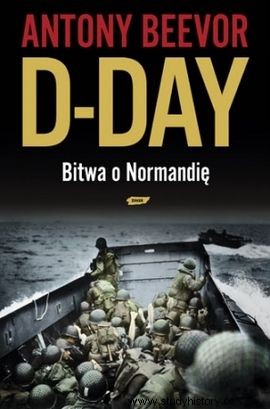
In the West, on June 12, the Desert Rats entered the action. Initially, their attack proceeded as planned, along the way, occupying other towns such as Livry, Tracy Bocage and finally Villers Bocage and the important hill 213 towering over the last town.
Already at the beginning of the attack, however, the commander of the 7th Division made a culpable mistake, sending the 11th Hussar Regiment (the best reconnaissance unit in the entire division) to the flank of the 22nd Brigade, which was the vanguard of the division.
With this move, the 22nd Brigade, occupying June 13, Villers Bocage, had no idea of the 101st heavy tank battalion under the command of Obersturmführer , hidden in the woods nearby. Michael Wittman.
This resulted in the legendary "Armageddon" of the 22nd Brigade, during which it lost 21 armored vehicles and had to retreat to Caumont by June 14 .
The Battle of Caen itself did not end until July 19, almost a month and a half later than Montgomery had promised. In addition, the implementation of the "brilliant" plan of the future marshal cost the Allies 50,000. killed and wounded soldiers.
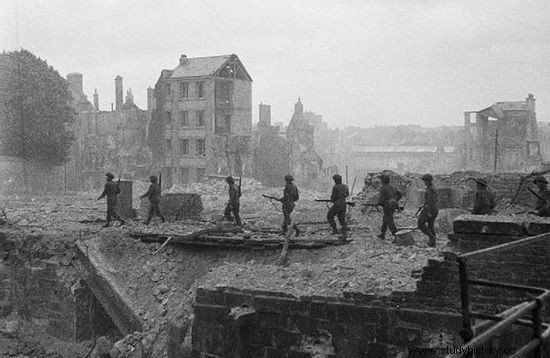
Soldiers of the Royal Corps of Engineers in what's left of Caen. July 1944
Wrong applications
Worse, after the defeat of the operation, not only Montgomery, but also most of the Allied command did not draw any constructive conclusions from it. The shortcomings of the entire operation clearly proved that the use of airborne troops dropped behind enemy lines cannot be achieved without efficient and quick support from ground units.
Worst of all, however, was the fact that Monty tried such a tactic in the near future on a much larger and, bold enough to say, catastrophic scale in September 1944 in the Netherlands. Had it not been for General Mallory's explicit opposition, this offensive might have ended similarly to Operation Market-Garden. So a "90% win".
